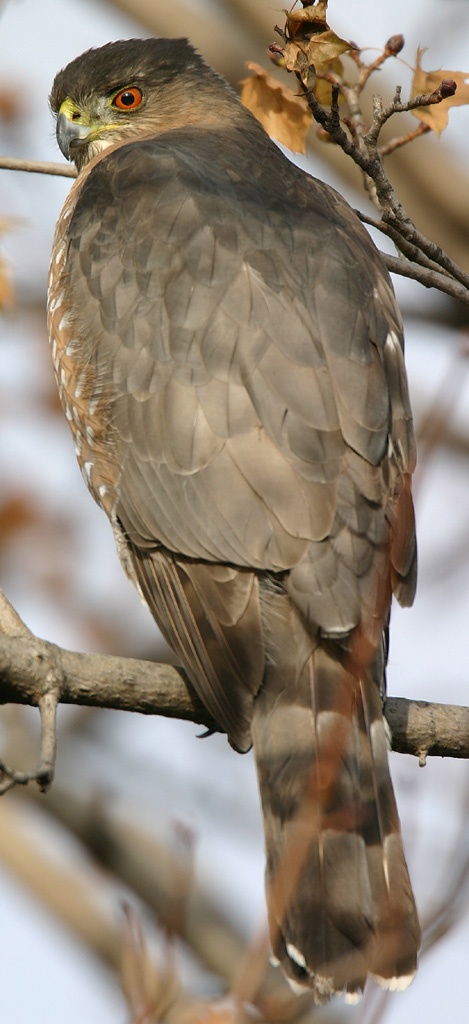Hunters who spend a lot of time afield in the fall are likely to observe all sorts of amazing animal behavior, none more awe-inspiring than the aerial skills of the Cooper’s Hawk (Accipiter cooperii).
Like all raptors in this genus, the Cooper’s Hawk hunts on the wing, while flying through timber and brush. Its hunting skills are the very definition of stealth and surprise.

The Cooper’s Hawks’ hunting skills are the very definition of stealth and surprise. (Photo by Johann Schumacher Audubon Society)
Fast and agile, this hawk can grab a bird in mid-air or pin a squirrel or chipmunk to the ground in the clutch of its sharp talons. A favorite attack maneuver is to fly fast and low to the ground, then up and over brush, or around a tree, to surprise prey on the other side.
Range and Distribution
The Cooper’s Hawk is found statewide and present year-round.
In the Kentucky Breeding Bird Atlas, author Brainard Palmer-Ball Jr. wrote that the Cooper’s Hawk has been “increasing in numbers since the 1980s,” recovering from a population downturn in the 1960s and 1970s.
Each fall and winter numbers spike across the state because of an influx of migrant birds from the Great Lakes states and southern Canada, the northern reaches of its range.
The Cooper’s Hawk is found most often in forested regions of North America, less prevalent in plains and arid landscapes. Wintering birds may go as far south as southern Florida, Texas, central Mexico and Baja California.
Size and Coloration
A medium-sized hawk with broad, rounded wings, and a long rounded tail, the Cooper’s Hawk has a large head, broad shoulders and red eyes.

The Cooper’s Hawk is found statewide and present year-round in Kentucky. (Photo from Wikipedia Commons)
Similar in coloration and often confused with the Sharp-Shinned Hawk, adult Cooper’s Hawks are steely blue-gray above with dark, reddish bars on the underparts of their wings, and thick dark bands on the tail.
Juveniles are brown above and streaked with brown on the upper breast.
Adult males are smaller than adult females, who can weigh up to 15 ounces and be 20 inches long from head to tail, with a wingspan of up the 37 inches.
On average, birds in the eastern U.S, are larger than birds in the western states.
Habitat
In central Kentucky, the Cooper’s Hawk is abundant where there is a mix of forested and open land, most conspicuous in rural farmlands at the wood’s edge.
But, they may frequent rural subdivisions, large forested parks near cities and wooded neighborhoods because of the large numbers of prey species available. Don’t be surprised if you see a Cooper’s Hawk swoop down and grab a songbird at the backyard bird feeder.
Food Habits
The Cooper’s Hawk feeds primarily on birds and small mammals, most often chipmunks, squirrels and mice and sometimes reptiles, such as small snakes.
On Kentucky farmlands, targeted bird species include the Mourning Dove, European Starling, and Common Grackle.
Reproduction and Nesting
In courtship, pairs of these hawks may fly together over their territory with slow, exaggerated wingbeats.
In Kentucky, nesting begins in April and continues through June.

Cooper’s Hawks are steely blue-gray above with dark, reddish bars on the underparts of their wings, and thick dark bands on the tail. (Photo from Wikipedia Commons)
The male Cooper’s Hawk feeds its mate for up to a month before she begins laying eggs.
Their nest site is in a tree, usually 25 to 50 feet above the ground, often placed on top of some old nest of a large bird or squirrel. It’s a bulky structure of sticks, lined with softer material such as strips of bark.
On average the females lay three to five, pale bluish-white eggs, which she incubates for about 35 days.
The male brings her food while she is on the nest, and sits on the eggs for a few minutes while she is eating.
For the first few weeks after hatching, the female stays with her young, feeding them the kill brought to the nest by the male.
The young begin to climb out of the nest to nearby tree limbs soon afterward and can fly at about four to five weeks.
As cold weather sets in and the last of the leaves have fallen, hawks are more visible, perched in trees along rural roadways, or soaring over-harvested crop fields at the wood’s edge.
Keep an eye out for the Cooper’s Hawk, a winged predator with distinctive hunting skills.
Art Lander Jr. is outdoors editor for KyForward. He is a native Kentuckian, a graduate of Western Kentucky University and a life-long hunter, angler, gardener and nature enthusiast. He has worked as a newspaper columnist, magazine journalist and author and is a former staff writer for Kentucky Afield Magazine, editor of the annual Kentucky Hunting & Trapping Guide and Kentucky Spring Hunting Guide, and co-writer of the Kentucky Afield Outdoors newspaper column.























